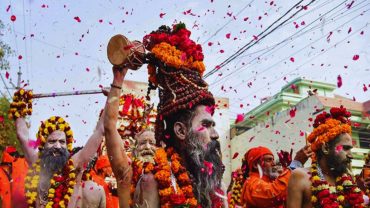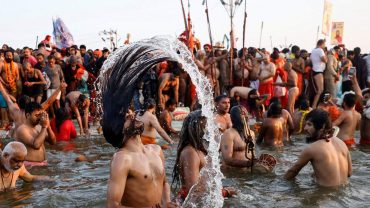Explore the soulful ambiance of Varanasi at Assi Ghat! Our guide highlights the best places to visit in Varanasi at Assi Ghat, offering a captivating journey through spiritual sanctuaries, lively markets, and historical marvels along the sacred Ganges River. Immerse yourself in the rich tapestry of this ancient city, creating unforgettable memories in the heart of Varanasi.

Why is Assi Ghat famous?
According to the traditional history, it’s aforesaid that the god Durga (consort of Lord Shiva) had thrown her blade within the watercourse (called Assi River) when killing the demon Shumbha-Nishumbha. Assi steps is represented within the Kashi Khand as “Assi Saimbeda Tirtha” means that the one who gets a dip here once in his life can get Punya (blessings) of all the Tirthas (religious places of the Hindu). usually, Hindu pilgrims gather to require a holy dip here within the Chaitra (month of March/April) and Hindu calendar month (month of Jan/Feb) yet as another vital event like solar/lunar eclipse, Probodhoni Ekadashi and Makar Sankranti.
At these steps, an enormous Shiva symbol is settled beneath the Peepal tree wherever pilgrims supply Jal and worship when taking holy tub within the Ganga water. Another Shiva symbol is – Asisangameshwar symbol, in a very tiny temple of the marble just about the Assi steps. The steps have been conjointly represented within the ancient Hindu kinds of literature just like the Matsya Purana, Kurma Purana, Padma Purana, Hindu deity Purana and Kashi khanda.
More about Assi:
All the religious journey routes undergo the south certainly touch this site. Even within the ancient mythologies, the Asi groove was mentioned as a seasonal stream and a dried bed. The temple of Asi Sangameshvara (“Lord of the Confluence of Asi”) marked with a marble bladed establishes the puranic heritage of the location. The plaque reads that “in the Pancakroshi pilgrimage, this site is one among the Pancatirthis”.
This ghat was mentioned within the inscriptions of the Gahadavalas (11th-12th century). In Varadaraja’s Giravana-padamanjari (1600-60) this ghat is additionally described with glory. By the turn of the 19th century, the long strip of the Ghat got divided into separate ghats. In 1902 the Queen Dulhin Radha Dulari Kunwar of the Sursand Estate (Bihar) had purchased the southern a part of the ghat and built her small palace (presently Hotel Ganga View) and also the Lakshminarayana Temple.

What to do at Assi ghat?
1. Plunge into the holy Ganges:
The Ganges has always been considered a sacred river, which has been washing the sins of this earth for millions of years. After coming to Kashi, their greatness is at its peak, in Hindu religion, they have been given the status of mother. It is said that it passes from Shiva’s coats to the entire north-western part of Gangotri. Whoever takes a bath in this river with devotion, all his sins are washed away.
2. Boating/Sightseen at Assi Ghat:
On the morning of Assi Ghat, the red rays that fall on your mouth through Mother Ganga through pure water, it seems as if someone has put thousands of happiness together in your bag. That subah-e-Banaras Ganga Aarti Assi ghat gives peace to the whole mind. In the evening when the rays of the sun take off their light with pride and there is a different view of the Aarti occurring amidst the noise and liquor of the city, which people see from different perspectives, some sit in a boat and some stand and separate Devoutly
3. Enjoy the stairs (A Great Happiness):
The stairs of Assi Ghat have a different significance. Hundreds of tourists come here to enjoy these stairs. A different image of India is seen here every day, which plays an important role in itself. The theatre of subah-e-Banaras thrills everyone’s heart, the crowd of stairs gives you the most special identity, by sitting on these stairs, people have found a way to take their life forward. The shops around the stairs, which have a ruthless appearance of the beauty of Kashi.
Conclusion:
Assi Ghat, steeped in myth and spirituality, stands as a symbol of Varanasi’s rich history. The legend of Goddess Durga infuses divine significance, making it “Assi Saimbeda Tirtha” – a place where a dip equals blessings from all Hindu Tirthas. Pilgrims gather during auspicious times, and the Shiva idols by the river, coupled with the temple of Asi Sangameshvara, amplify the spiritual aura.
Beyond myth, Assi Ghat is a historical nexus, mentioned in ancient texts and inscriptions. Its evolution, from a seasonal stream to a divided ghat, reveals layers of time. Queen Dulhin Radha Dulari Kunwar’s contributions in 1902 add a royal touch.
For visitors, Assi Ghat is an immersion in spirituality. From the purifying Ganges dip to tranquil boating and witnessing subah-e-Banaras on its iconic stairs, every moment is an encounter with Varanasi’s soul. In essence, Assi Ghat transcends history, inviting all to partake in the eternal dance of life along the sacred Ganges.
FAQs for Places to visit in Varanasi at Assi Ghat:
Why is Assi Ghat famous?
Assi Ghat is renowned for its historical and religious significance. According to traditional history, it is believed that the goddess Durga threw her blade into the Assi River after slaying the demon Shumbha-Nishumbha. Pilgrims gather here for a holy dip during significant events such as Chaitra, Hindu calendar month, solar/lunar eclipses, Probodhoni Ekadashi, and Makar Sankranti.
What more is there to know about Assi Ghat?
Assi Ghat holds a special place in religious journeys, with routes passing through it. The Asi groove, mentioned in ancient mythologies, is described as a seasonal stream and a dried bed. The temple of Asi Sangameshvara, marked with a marble blade, reflects the puranic heritage of the location. Inscriptions from the Gahadavalas (11th-12th century) and literary references like Varadaraja’s Giravana-padamanjari (1600-60) highlight the ghat’s historical importance.
What historical aspects are associated with Assi Ghat?
Assi Ghat has been mentioned in ancient Hindu literature like the Matsya Purana, Kurma Purana, Padma Purana, Hindu deity Purana, and Kashi khanda. The ghat finds reference in inscriptions of the Gahadavalas (11th-12th century) and the Giravana-padamanjari (1600-60). In the 19th century, the ghat got divided into separate sections, with Queen Dulhin Radha Dulari Kunwar building her palace and the Lakshminarayana Temple on the southern part in 1902.
Are there accommodations near Assi Ghat?
Yes, the southern part of Assi Ghat is home to Hotel Ganga View, originally a palace built by Queen Dulhin Radha Dulari Kunwar in 1902. It provides accommodation and adds to the historical charm of the ghat.



Comment (0)